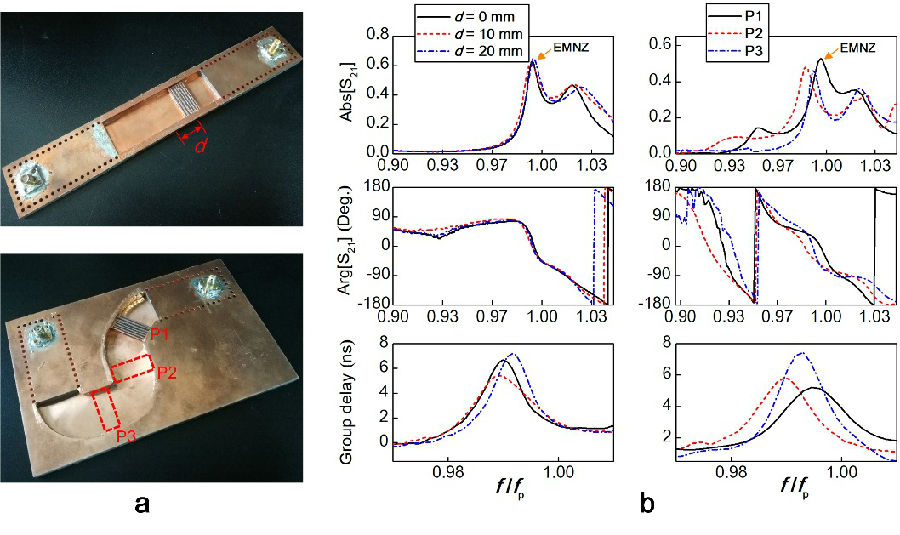On September 11, the research group of Associate Professor Li Yue of the Department of Electronic Engineering, Tsinghua University published a research paper entitled "Substrate-integrated photonic doping for near-zero-index devices" inNature Communications, in which, the substrate-integrated photonic doping method was proposed for the first time to realize functional devices with near-zero-index electromagnetic characteristics, and provide new design methods for new chip integrated circuits, so it has a wide potential application in fields such as biosensing, integrated circuits and functional materials.

Conceptual graph of the substrate-integrated photonic doping: (a) Linear structure, (b) Bending structure
Near-zero-index devices are a class of functional devices based on near-zero-index media. Compared with traditional electromagnetic devices, they have the characteristics of deformability, local adjustment, and field enhancement. In the near-zero-index media, electromagnetic waves exhibit a special fluctuation effect of spatial static distribution, including near-zero refractive index and group velocity, as well as wavelength and phase velocity approaching infinity. In 2017, Professor Nader Engheta from the Department of Electrical & Systems Engineering, University of Pennsylvania and Associate Professor Li Yue collaborated on an article in Science, in which, the concept of photonic doping based on near-zero-index media was proposed for the first time, the doping technology was transplanted from the micro-scale to the macro-scale and the magnetic conductivity of the equivalent media was adjusted through the form of non-ordered structured media doping, so as to realize the control of multiple modes such as paramagnet, diamagnet, and ideal magnet. It is a class of equivalent medium theory based on aperiodic structure.

Experimental observation of the substrate-integrated photonic doping characteristics: (a) Test platform, (b) Near-zero reflection, zero phase, high-group delay phenomenon
Taking the engineering application of the new theory as a starting point, a substrate-integrated photonic doping method was proposed in this paper. Combined with typical integrated circuit technology, the control of the equivalent media magnetic characteristics by photonic doping is manifested as the control of electromagnetic response of the integrated chip devices and multiple near-zero-index functional devices are realized, such as using high sensitivity biosensors with local field enhancement effect in doped media, high-efficiency optoacoustic modulator with weak mechanical vibration, "electric fiber" with random bending and deformation, and constant operating frequency (analogous to optical fiber). In addition, the team of Associate Professor Li Yue verified the electromagnetic characteristics of the substrate-integrated photonic doping concept by experiments, and observed that zero phase shift, high time delay, independence of the position of the doping media, and independence of the device shape, etc., were consistent with analytic theory predictions and full-wave simulation results.
The theoretical and experimental work of this paper was completed in Tsinghua University, and the Department of Electronic Engineering, Tsinghua University is the first unit of the paper. Associate Professor Li Yue and Professor Nader Engheta from the Department of Electrical & Systems Engineering, University of Pennsylvania are the corresponding author of this article, and Zhou Ziheng, a doctoral student in the Department of Electronic Engineering, is the first author of the article. Other authors include Li Hao and Sun Wangyu, doctoral students in the Department of Electronic Engineering, Tsinghua University, and Dr. Inigo Liberal from the Public University of Navarre. The research was sponsored by the National Natural Science Foundation of China (61771280) and sponsored by the National Lab of Tsinghua Information Science and Technology.
Paper link: https://www.nature.com/articles/s41467-019-12083-y